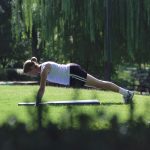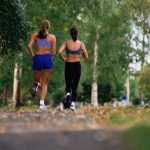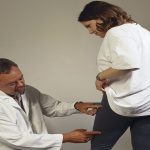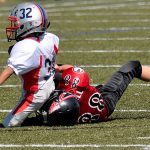(HealthDay News) — A tragedy can happen in any swimming pool without proper supervision, says Intermountain Healthcare. Following water safety guidelines can prevent children from drowning. Intermountain Healthcare urges parents to: Always watch children who are in the water. Be alert. Learn infant and child CPR. Have a phone nearby in case of emergency. Never leave children alone or with siblings. Enclose a pool inside a fence. Teach children to swim.
All Sports:
Young Athletes Need to Be Sidelined After Bout of Mono

Young sports buffs recovering from mononucleosis may be itching to return to the game they love. But one expert says the risk of suffering a burst spleen during play means staying on the sideline longer than some would like. Along with extreme fatigue, sore throat, fever and swollen glands, “mono” causes spleen enlargement. That can be dangerous for athletes because the impacts and pressure on the abdomen that occur during many sports can cause the spleen to burst. “It’s rare — occurring in less than 0.5% of patients — but an infected athlete can rupture their spleen without warning within 21 days after symptoms begin,” said Dr. Lindsay Lafferty, a primary care sports medicine physician at Penn State Health. “The rate declines after four weeks, but ruptures have occurred up to eight weeks after an athlete first notices symptoms,” she noted in a Penn State news release. Determining the risk of a spleen rupture is challenging. Because the normal size of a spleen fluctuates, ultrasounds and CT scans won’t help determine if the organ is enlarged or at risk of rupture, Lafferty said. “Physical examination of spleen size identifies as few as 17% of cases, so deciding when the time is right for a student athlete to return to play can be complex,” she explained. For athletes, protective equipment such as flank jackets or protective… read on >
Health Tip: Horseback Trail Riding Safety
(HealthDay News) –Horseback trail riding is a fun, leisure activity for many Americans. However, it is important to follow rules for trail safety, says the Minnesota State Department of Natural Resources. It encourages people to: Wear a helmet and appropriate footwear. If your horse kicks, tie a red ribbon in its tail. Do not bring unruly horses on public trails. Ride in groups. Carry a trail map and cellphone.
Step-by-Step Exercises for a Stronger Back

Are you neglecting or even unaware of the muscles in your back? If so, you’re putting yourself at risk. The trapezius is the diamond-shaped muscle that runs from neck to middle back and from shoulder to shoulder across the back. The latissimus dorsi — or “lats” — are the large back muscles that run from either side of the spine to your waist. Here are two strength-training exercises that will help you develop these muscles for better upper body fitness. Important: Start with a weight that allows you to complete at least eight reps with proper form, perhaps as low as 2-pound dumbbells. Build up to 10 to 15 reps for one complete set, and progress from one to three complete sets before increasing the weight. Never jerk the weights — controlled, steady movement is what brings results. Standing dumbbell rows target the trapezius muscles as well as the upper arms and shoulders. Stand straight, feet shoulder-width apart, with a weight in each hand. Your elbows should be slightly bent, the dumbbells touching the fronts of your thighs, palms facing your body. As you exhale, use a slow, controlled movement to lift the weights straight up by bending the elbows up and out to bring the weights to shoulder level. Hold for a second, then inhale as you lower your arms to the starting position.… read on >
The 7-Minute Workout

Are you in a time crunch for even a short workout? Experts at the American College of Sports Medicine created a 7-minute plan that can fit into almost anyone’s schedule. The program uses high-intensity training in an exercise circuit, meaning that you quickly progress from one exercise in the circuit to another, exercising full out for each one (that’s the “high-intensity” part of the training plan). This workout combines cardio and resistance work into a single session. Some moves target specific muscle groups; others work the entire body. Do each of the 12 exercises for 30 seconds, which should be enough time to complete between 15 and 20 repetitions, the optimal amount. Take a 10-second break as you transition from one exercise to the next, but no longer so that you don’t lose the benefits of the high-intensity technique. 7-Minute Circuit Exercises 1. Jumping jacks to benefit your entire body 2. Wall sits to target your lower body 3. Push-ups to target your upper body 4. Abdominal crunches to target your core 5. Step-ups to benefit your entire body 6. Squats to target your lower body 7. Triceps dips to target your upper body 8. Planks to target your core 9. Running in place to benefit your entire body 10. Lunges to target your lower body 11. Push-ups to target your upper body 12. Side… read on >
The 7-Minute Workout

Are you in a time crunch for even a short workout? Experts at the American College of Sports Medicine created a 7-minute plan that can fit into almost anyone’s schedule. The program uses high-intensity training in an exercise circuit, meaning that you quickly progress from one exercise in the circuit to another, exercising full out for each one (that’s the “high-intensity” part of the training plan). This workout combines cardio and resistance work into a single session. Some moves target specific muscle groups; others work the entire body. Do each of the 12 exercises for 30 seconds, which should be enough time to complete between 15 and 20 repetitions, the optimal amount. Take a 10-second break as you transition from one exercise to the next, but no longer so that you don’t lose the benefits of the high-intensity technique. 7-Minute Circuit Exercises 1. Jumping jacks to benefit your entire body 2. Wall sits to target your lower body 3. Push-ups to target your upper body 4. Abdominal crunches to target your core 5. Step-ups to benefit your entire body 6. Squats to target your lower body 7. Triceps dips to target your upper body 8. Planks to target your core 9. Running in place to benefit your entire body 10. Lunges to target your lower body 11. Push-ups to target your upper body 12. Side… read on >
How to Start a Walking Group

You enjoy walking and even have an exercise buddy to keep you on track. But maybe your enthusiasm has started to wane. The answer? Expand your workout circle and form a walking group in your community. By planning walks and encouraging one another, each member will have an impact on everyone else’s health. Createthegood.org offers simple steps to get started. First, see if there’s already a community-based organization that might join forces with you or offer ideas, information and resources. Maybe there’s a nonprofit that you’d like to support through a walk six or 12 months from now — check out its website to see if it offers planning pointers for fundraising events. Next, decide how wide a net you want to cast to recruit members. You might keep the group to people you know or extend it to include friends of friends. Hold a kick-off meeting and work out key details like the days and times the group will meet, how long you’ll walk each time and a list of routes that will keep things interesting. Set up a system for contacting one another by text or e-mail so you can send updates and reminders before each walk. If you’d rather join a group than start one, check out Walkwithadoc.org. Started in 2005 by David Sabgir, a cardiologist in Columbus, Ohio, it has chapters… read on >
Three Exercises for Stronger, Sleeker Thighs

Wall sits, leg curls and leg lifts are three effective thigh exercises that don’t require any strength-training equipment — just your own body weight, so you can do them virtually anywhere, even at the office. Here’s how to exercise with proper form. Wall sits are also called the invisible chair. Stand with your back firmly against a wall and move your feet out in front of you by about one big step. Now slide your back down the wall, bending your knees until your thighs are parallel to the floor and make a 90-degree angle with your upper body. Hold this position for up to 60 seconds. You may only be able to do a few seconds at first — gradually lengthen the hold over time. You may keep your arms along the wall for balance. To add to the challenge as you progress, hold them out in front of you. Aim for a set of three reps, and increase sets as you strengthen muscles. Now grab a real chair for leg curls. Stand behind the chair, flex your right foot and bring your right heel toward your butt. Hold briefly, then slowly lower the foot to the starting position. Repeat 10 times, then switch legs and repeat. Aim for three sets, or 30 curls, on each leg. To add to the challenge, you can… read on >
Most Parents Want Age Limits on Football Tackling

With concern over concussion dangers rising, most U.S. parents now say that they would support bans on tackling in youth football, a new survey shows. Researchers found that of more than 1,000 parents in a national sample, 60 percent were in favor of age restrictions on tackling. Another quarter were in the “maybe” camp. The study, published online April 1 in the journal Pediatrics, dovetails with growing fears about sports-related concussions in children and teenagers. The rate of concussion in youth sports remains fairly low; but research suggests that because so many U.S. kids play sports, it translates to as many as 1.9 million concussions a year among 5- to 18-year-olds. So, various sports organizations have laid out new rules to protect young athletes from head injuries. For example, youth soccer leagues recommend that kids younger than 11 avoid “heading” the ball, while USA Hockey advises against “body checking” for players younger than 13. The issue of tackling in youth football remains debated, though. The new study tried to gauge where parents stand, since their views are crucial, said lead author Dr. Sara Chrisman, of Seattle Children’s Research Institute. Her team found that few parents — 15 percent — were against age restrictions on tackling. And moms and dads were generally on the same page: 58 percent of men and 63 percent of women supported… read on >
One Short, Brisk Walk a Day May Keep Arthritis at Bay

Less than 10 minutes a day of brisk walking can help prevent disability in people with arthritis pain in their knee, hip, ankle or foot, researchers report. Just one hour a week of brisk physical activity “is less than 10 minutes a day for people to maintain their independence. It’s very doable,” said lead study author Dorothy Dunlop. She’s a professor of preventive medicine at Northwestern University’s Feinberg School of Medicine in Chicago. “This minimum threshold may motivate inactive older adults to begin their path toward a physically active lifestyle with the wide range of health benefits promoted by physical activity,” Dunlop added in a university news release. She and her team analyzed four years of data from more than 1,500 older adults in Baltimore, Pittsburgh, Columbus, Ohio, and Pawtucket, R.I., who had pain, aching or stiffness in their lower joints from osteoarthritis but were initially free of disability. The participants’ levels of physical activity were monitored using a wearable device. An hour a week of moderate-to-vigorous physical activity reduced their risk of disability, the study found. Specifically, the activity reduced the risk of walking too slowly to safely cross a street by 85 percent, and their risk of not being able to do daily living activities — for example, morning routine tasks such as walking across a room, bathing and dressing — by nearly… read on >




















-300x200.jpg)







-300x169.jpg)
